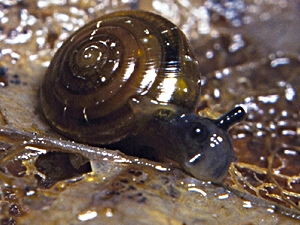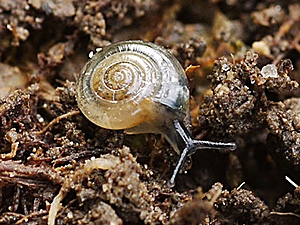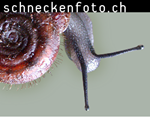
Pristiloma stearnsii from British Columbia, Canada.
Picture: Kristiina Ovaska. Source: CalPhotos.
 Pristiloma stearnsii from British Columbia, Canada. Picture: Kristiina Ovaska. Source: CalPhotos. |
The Pristilomatidae family of terrestrial snails is a part of the Gastrodontoidea superfamily, together with some true glass snails (Oxychilidae) and the hive snails (Euconulidae).
Class:
Gastropoda
![]() Subclass:
Pulmonata
Subclass:
Pulmonata
![]() Superorder:
Eupulmonata
Superorder:
Eupulmonata
![]() Order:
Stylommatophora
Order:
Stylommatophora
![]() Suborder:
Sigmurethra
Suborder:
Sigmurethra
![]() Infraorder:
Arionoinei
Infraorder:
Arionoinei
![]() Superfamily:
Gastrodontoidea
Superfamily:
Gastrodontoidea
![]() Family:
Euconulidae Reinhardt 1883
Family:
Euconulidae Reinhardt 1883
![]() Source:
Mollbase on
http://www.mollbase.de/list/, Fauna Europaea on
http://www.faunaeur.org.
Source:
Mollbase on
http://www.mollbase.de/list/, Fauna Europaea on
http://www.faunaeur.org.
Snails of the nomenclatorial genus Pristiloma, for example, are found in British Columbia, Canada.
Today, also all native species of small and tiny terrestrial snails are counted among the Pristilomatidae, which had formerly been known as the crystal snails' (Vitreinae) subfamily in the true glass snails' (Zonitidae) family.
![]() Relatives of glass snails (Vitrinoidea).
Relatives of glass snails (Vitrinoidea).
Apart from species native to Europe, the Pristilomatidae family is widely distributed: Members of this family can be found in the Nearctic (North America), the Neotropic (South America), the Palaearctic (North and West Eurasia), Polynesia and Hawaii (see also: Faunal provinces of the Earth).
Common Crystal Snail - Vitrea crystallina (O. F. Müller 1774)
 Common crystal snail (Vitrea crystallina). Picture: © Stefan Haller, (schneckenfoto.ch). |
The common crystal snail is probably the commonest crystal snail species native to Europe.
Description: The depressed disc-shaped shell of the common crystal snail is quite variable, but it is different from other crystal snail shells by its widened apertural whorl, which may be as wide as 1½ time the previous whorl. The shell surface is very finely striated, but appears shining, slightly greenish in colour and translucent. The shell navel (umbilicus) is narrow (about one eighth of the maximal shell diameter), but it is open enough, so the penultimate whorl remains visible.
Dimensions: H: 1.4 - 2.1 mm; W: 3.1 - 4.0 mm; N: 4 - 5. (Abbreviations).
Habitat and Distribution: The common crystal snail lives in the leaf litter and under stones in humid forests, also hides in the mosses. Vitrea crystallina is a typical species of alluvial riverside forests and is also found in wet meadows and in swamp areas. On the riverside it lives between herbs and in the reeds.
Its habitat Vitrea crystallina often shares with other crystal snail species, such as Vitrea diaphana and Vitrea contracta (picture).
![]() Reischütz,
P. L. (1996): "Die Molluskenfauna von Wäldern mit hohem Totholzanteil im Bereich
des Wienerwaldes.", Wiss. Mitt. Niederösterr. Landesmuseum 9, 163
- 172 (PDF).
Reischütz,
P. L. (1996): "Die Molluskenfauna von Wäldern mit hohem Totholzanteil im Bereich
des Wienerwaldes.", Wiss. Mitt. Niederösterr. Landesmuseum 9, 163
- 172 (PDF).
The common crystal snail is distributed throughout almost all of Europe, with the exception of the extreme south. In Norway, the species' distribution area stretches as far as 65° n. L. In Switzerland, in the Valais, the species climbs to altitudes of up to 2300 m MSL.
Vitrea crystallina has been introduced, for example, to Australia.
![]() Francisco Welter-Schultes:
Vitrea crystallina species homepage.
Francisco Welter-Schultes:
Vitrea crystallina species homepage.
![]() Mollbase:
Vitrea (Crystallus) crystallina (Gemeine Kristallschnecke). (In German)
Mollbase:
Vitrea (Crystallus) crystallina (Gemeine Kristallschnecke). (In German)
![]() NABU Sachsen:
Zwerge im Seggenwald. (In German)
NABU Sachsen:
Zwerge im Seggenwald. (In German)
![]() Ehrmann,
P.: "Mollusca", in: "Die Tierwelt Mitteleuropas", 1956, p. 92 f.
Ehrmann,
P.: "Mollusca", in: "Die Tierwelt Mitteleuropas", 1956, p. 92 f.
 With pictures by Stefan Haller: http://www.schneckenfoto.ch. |